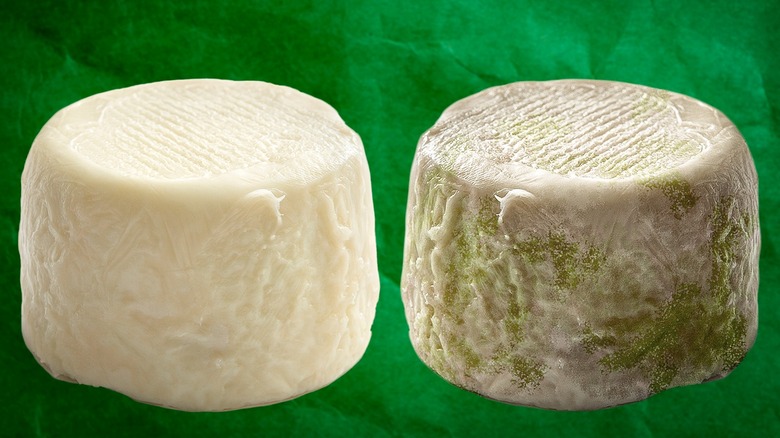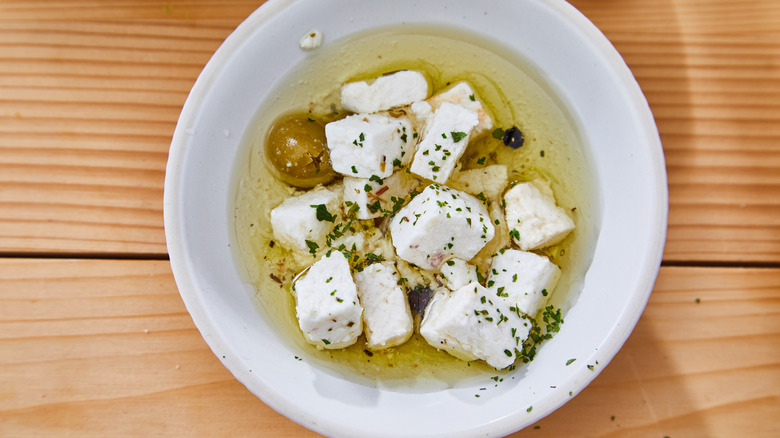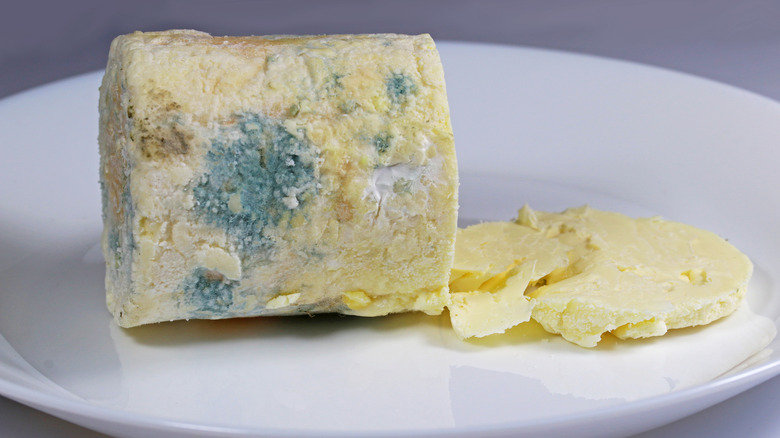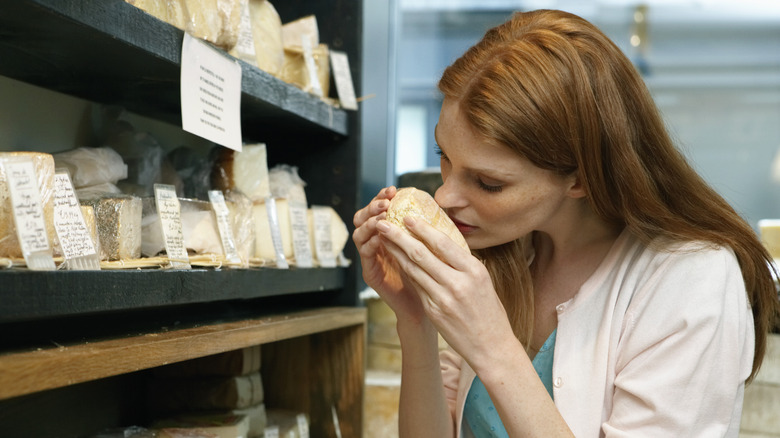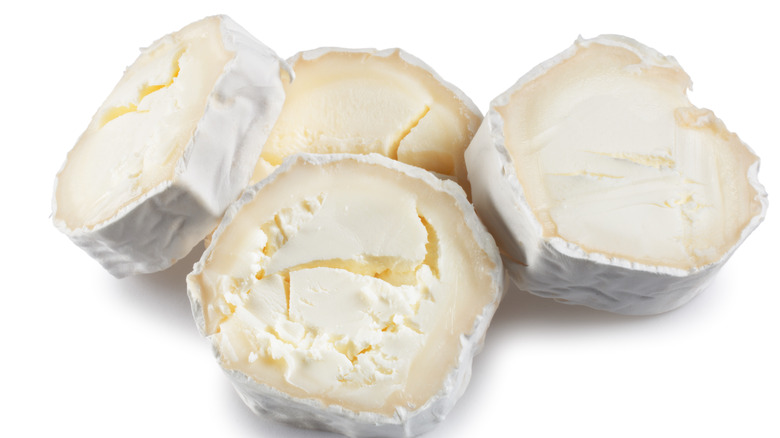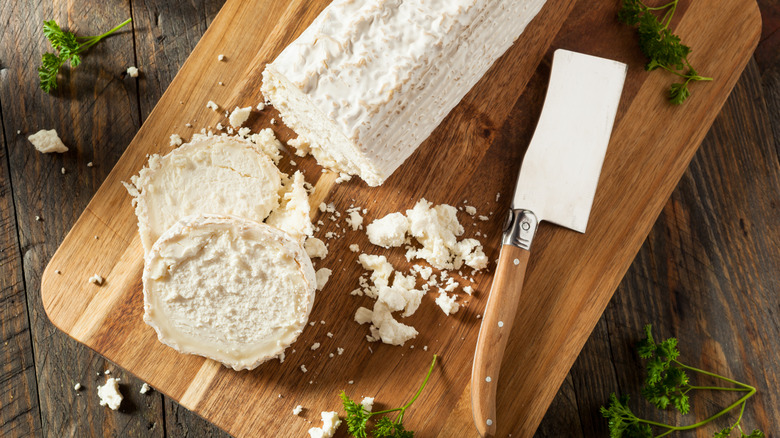Telltale Signs That Your Goat Cheese Has Gone Bad
There's a joke that often goes around on social media, asking "How do you even know if yogurt has spoiled?" It's technically milk that's gone sour because it's full of bacteria, so it can be genuinely tricky to know when it's gone off.
The same holds true for goat cheese because even at its best and freshest, goat cheese has a distinctive funk that sets it apart from most others. If you don't buy it regularly, it can be hard to know when it's gone off and when it's just supposed to smell like that. It's not as difficult with aged goat cheeses or a goat's milk Brie because those behave like any other cheese of their type.
With fresh goat cheese, though, the soft and spreadable kind — the one most recipes call for — it can be tougher to pick up on the signs that your cheese has gone south. Yes, some are obvious, but some are not. I'm a trained chef and formerly a certified food safety trainer, so I bring some professional expertise to the problem. Here are some of the things you should be looking for.
Check the best-by date on your goat cheese
Checking the best-by date is always a good starting point, as long as you understand that it is indeed just a starting point. The manufacturer will always put a best-by or use-before date on the cheese, which is an estimate of how long the cheese will retain its best flavor.
As the USDA explains, this isn't an "expiration date": your cheese will still be food safe after that date, but it's up to you to decide when you've hit the use-it-or-lose-it stage. Fresh, soft goat cheese is usually good for up to a week in your refrigerator, and some sources say it may last up to 2 weeks.
The problem is that these recommendations are based on the assumption that the cheese is properly sealed and that it has been kept at a food-safe refrigerator temperature for the entire two weeks. That includes the time you've spent getting home from the store and getting your groceries put away; the longer it sits at your ambient temperature, the greater the risk of bacterial growth. That's why the date is an indicator but not a reliable guide. To know for sure whether your goat cheese has spoiled, you'll need to rely on your senses.
Spoiled goat cheese may change color
One of the things that makes soft, fresh goat cheese so appealing to chefs is its snowy white color. It creates a beautiful visual contrast with deep-colored vegetables, which is why roasted beets and goat cheese are a classic salad pairing.
That perfect white hue is a result of goat biology. Although grassy plants are green, they contain a lot of beta carotene, which gives cow's milk its signature yellow tone. (That's why we call certain shades of off-white "creamy.") Goats process beta carotene differently, leaving it colorless; as a result, milk and fresh cheeses made from goat milk will always naturally be pure and white.
If your fresh goat cheese has yellowed noticeably and acquitted the kind of off-white tint you'd see in, say, Swiss cheese or Havarti, you can be confident that it's past its prime. That's the most common color change you'll see, though in some cases, a goat cheese retrieved from a forgotten corner of your fridge may show vivid yellow, orange, or pink hues. Believe it that the "sniff test" is a bad idea at this point. Just discard it and substitute something else in your recipe if necessary.
Sticky slime means your goat cheese is past its prime
The whole point of making cheese, yogurt, and other fermented dairy products is to give milk — a highly perishable but high-value, high-protein food — an extended storage life. The beneficial live bacteria in yogurt, for example, make it acidic enough to be inhospitable to potentially dangerous competitors (pathogens). Yogurt will still spoil over time, but it lasts a lot longer than plain milk.
Fresh cheeses don't have the benefit of long aging or bacterial activity, like yogurt or hard cheeses. That means they're just as perishable as milk itself, and the USDA recommends not keeping them longer than a week in your fridge. Beyond that point, they're prone to bacterial growth. Discoloration is one potential sign of bacterial growth, but another is the presence of a bacterial film.
This is something you may have seen on deli meats, which are prone to the same problem. Bacterial film is a thin layer of clammy, slimy fluid that adheres to the surface of the goat cheese and can also pool in the packaging. The coat resembles a thin mucus, but it is a no-brainer: if you see it, discard the cheese.
Blue or green mold on your cheese is a bad sign
Molds have a real affinity for cheese. That's not necessarily a bad thing, the occasional gag-worthy back-of-fridge discovery notwithstanding. The entire constellation of famous blue cheeses wouldn't exist without molds, and beneficial molds are responsible for creamy, rind-ripened cheeses like Brie and Camembert.
Which is all well and good, but that doesn't mean your goat cheese should look like it's wearing fuzzy pajamas. Only a blue cheese should show blue or green mold because they use very specific molds that are known to be safe. Random dark-colored molds showing up on your goat cheese are an automatic sign they should be discarded. A few less-common molds can show up in oddball shades like yellow and pink, and they're also bad news.
With hard cheeses, you can cut around the bad spot — about an inch in each direction — but that's not the case with fresh cheeses. Invisible filaments of mold are likely to have traveled throughout the whole thing. You should just discard moldy goat cheese because some of those molds produce nasty toxins, according to the USDA. The only exception is the white mold from Brie, which can linger in your cheese drawer and colonize your goat cheese or other cheeses. That one's not dangerous, but on the whole, it's better to be safe than sorry.
Goat cheese shouldn't smell bad (really)
As such things go, smells are an important telltale sign that your goat cheese has gone bad. Because of goat cheese's signature funk, it's also the one that's most problematic. This isn't unique to goat cheese by any means. There are lots of famous cheeses you wouldn't want to take on an airplane with you, but that can make it difficult to know when things have turned from a naturally challenging aroma into a sign of trouble.
If you sniff a goat cheese when it's fresh and new, there should be nothing unpleasant about its smell. The aroma should be fresh and milky, and that characteristically "goaty" smell should be mild and musky without having a sharp, unpleasant pungency. It's there, but it should just be a faint animal whiff, like the smell on your hands after you pet a dog. When the cheese has gone off due to mold or bacterial activity, that pleasantly mild funk will change noticeably.
If your goat cheese takes on a sharp or acrid smell, at the very least, it's approaching the point of no return (and has probably already passed it). You may even detect a nostril-searing ammonia note in your cheese, which is a clear sign of spoilage.
Your goat cheese has yellowed and dried
"Going bad" doesn't always mean a food has become dangerous to consume; sometimes, it just means that you wouldn't want to eat it anymore because it's unpleasant. Sour milk and freezer-burnt steaks won't make you sick, for example, but most of us don't get much enjoyment out of them.
A similar situation can happen with your goat cheese if you haven't wrapped it properly after it was opened. You may go back to finish the rest, crackers in hand, only to find that it has yellowed and developed a tough crust on the outside. This simply means that your goat cheese has dried out in your fridge's arid environment. If only part of your cheese is affected, you can cut that off and discard it and still eat the rest — unless it shows other signs of spoilage.
Even the potentially salvageable portion of the cheese may not taste as it should at this point. It could simply taste stale, but the same air that dried out the cheese may also have packed along unpleasant flavors from other foods in the fridge. If it otherwise seems fine, feel free to try it. However, be prepared for disappointment.
Your goat cheese tastes nasty
There's an old saying that "The proof is in the pudding," or to put it another way, "You never know till you try." When it comes to goat cheese, tasting it is the ultimate test.
If there's any doubt about your cheese still being usable, assuming it still looks fine and has no odd smells, your final option is to just taste a small bite before using it in your recipe. If it tastes nasty, spit it out and discard the cheese. It may or may not be food-safe, but if it's unpleasant to eat, that won't matter. Just get rid of it.
Use this test sparingly and sensibly: It's for goat cheese that's still close to its use-by date, not the dubious one you've found at the back of your fridge. Unless you know for sure that the cheese is close to its use-by date and that it has been kept cold since it was purchased, the sensible thing is not to take chances. As we say in food safety circles, "When in doubt, throw it out."
Storage and food safety with goat cheese
Goat cheese is like most other foods when it comes to spoilage. Everything fresh has a finite lifespan, and often, your eyes or your nose will tell you when that lifespan is up. Unfortunately, that's not the whole story.
It's important to understand that two kinds of bacteria can be in your cheese: spoilage bacteria and pathogens. Spoilage bacteria might make you gag, but typically won't make you sick. Pathogens, on the other hand — nasty bugs like E. coli, Staphylococcus aureus, and Listeria monocytogenes — can make you very ill indeed and can't be detected by sight, smell, or taste. So, how can you know for sure whether your goat cheese is safe?
Well, assuming that your retailer and their wholesaler followed proper cold-chain procedures, it should be safe up to the moment you put it in your cart and take it home. From that point, it's up to you to get it home to the fridge in a timely fashion (if it's at ambient temperature for 2 hours, it should be discarded). Once you've opened the cheese, wrap any leftovers in parchment or cheese paper and then in plastic or foil to keep moisture from evaporating. Plan to use up your leftovers within a day or two.
